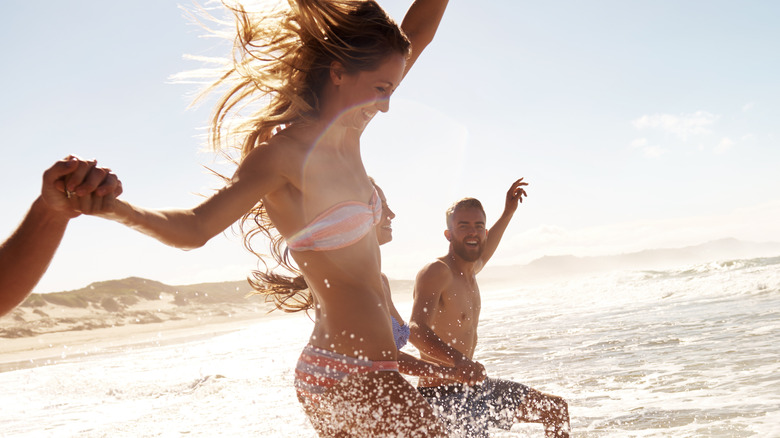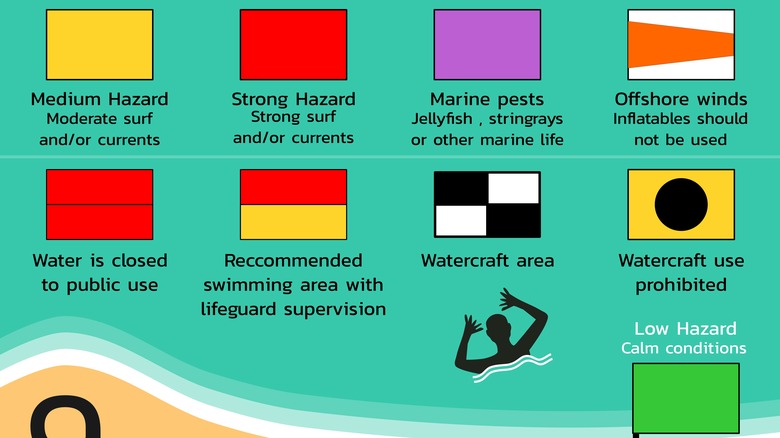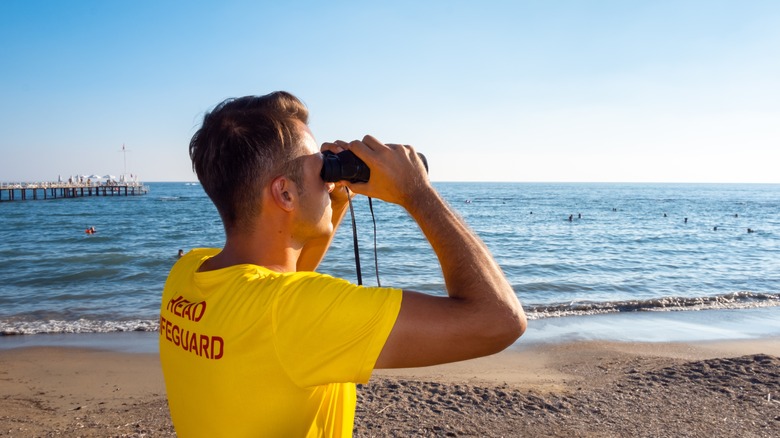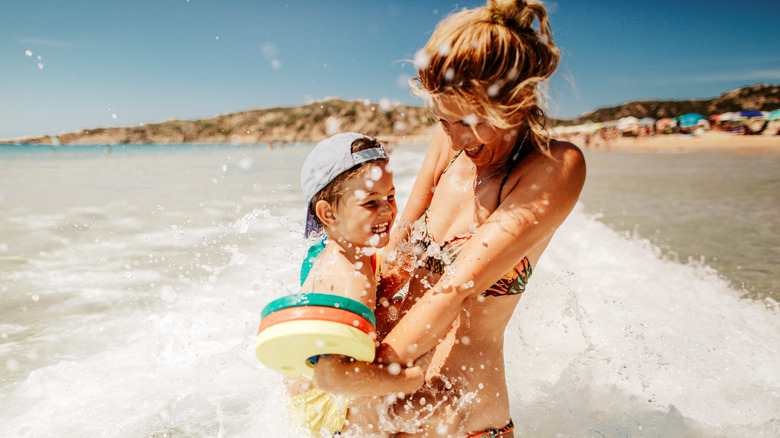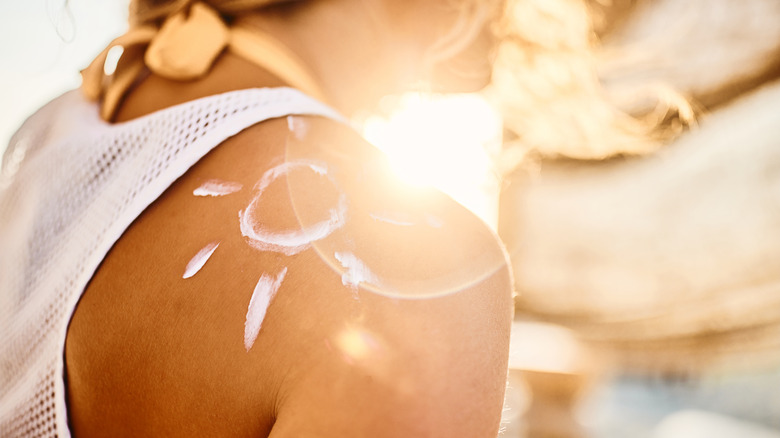How Beachgoers Can Stay Safe In And Out Of The Water
The sun, the surf, the sand, the summer. What's better than a blissful beach day? In our opinion, not too much. Whether you're looking to relax, play, or a bit of both, a day at the beach is, well, a day at the beach. It's just easy to enjoy. While we'd rather not play mom, calling you in from the water to rub sunscreen on your salty, yet a bit sunburnt face, we're about to. Just a quick dab of info for the brainwaves.
According to the United States Lifesaving Association, over 262 million Americans visited the beach each year. That's a lot of beachgoers. But, it's no coincidence that a lifesaving association produced this statistic. Beaches are more than fun and sun facilitators.
Oceans aren't wave pools. They're powerful, wild, and unpredictable, and there's a reason that lifeguards, who are rigorously trained, patrol popular beaches. Along with the ocean, getting too much sun isn't great, either, whether you're considering the long-term effects of UV rays or the prospect of a painful, aloe-lathered night. Beach days can be super fun, and by following a few safety tips, you can avoid both serious and less-serious summer bummers.
Familiarize yourself with the flags at the beach
The flags you'll find planted around public beaches aren't decorations. They're super important and will help you plan for your upcoming beach day. We won't go through all of the colors and their meanings, as you can scan the image above. However, we will offer you a quick shorthand to keep in mind.
Regarding the ocean's currents and overall surf strength, the flags follow the same color scheme as stop signs. Green means go, red means stop, and yellow means slow down. The red/yellow flag means the beach is supervised, and you should spot a lifeguard tower nearby.
If you're not a strong swimmer, visiting the beach with small children, a first-time beachgoer, or if it's a red flag-level, dangerous beach day, we'd recommend visiting a lifeguard-supervised beach. According to the United States Lifesaving Association, your chance of drowning on a lifeguarded beach is 1 in 18 million. As we said, they're rigorously trained. Finally, a purple flag usually means jellyfish. Not a few jellyfish. It means a lot of jellyfish or another type of sea critter (not sharks) you'd probably like to avoid.
Honestly self-assess your swimming abilities
As stated, oceans are powerful. Swimming in the ocean and swimming in a pool or lake isn't the same. While waves can knock you around, rip currents are the most dangerous hazards of ocean swimming. Basically, a rip current is a strong current that forms in the channel of a collapsed sandbar in the surf zone. After water rushes in, rip currents are like ocean rivers that quickly recede back into the ocean.
According to the National Oceanic and Atmospheric Administration, the speed of a rip current can move up to 8 feet per second, quicker than an Olympic swimmer. If Michael Phelps can't outswim a strong rip current, then you probably can't, either.
Around 80% of all lifeguard rescues involve rip currents. To avoid being a statistic, there are a few tips when it comes to rip currents. If you find yourself seemingly floating out to sea, then you're probably in one. After you realize this, don't panic, and don't try to swim directly back to shore (against the current). Rather, swim parallel to the shore until you're out. Serious rip current incidents occur when someone panics and wears themselves out trying to swim against a rip current.
Along with being aware of rip currents, you shouldn't turn your back to the ocean or swim alone. Overall, it's just important to honestly assess your swimming abilities, respect the ocean's strength, and know how to handle rip currents.
Take special precautions with kids
Family beach vacations are awesome. From sand-castle building and kite flights to sea critter hunts and boogie boarding, there's plenty to do for kids at the beach. With so many distractions, for kids and adults, we'd recommend spending a family beach day at a lifeguarded beach. This tip has nothing to do with parenting skills.
If your child gets caught in a rip current, how confident are you that you'd be able to help? Again, beach lifeguards exist for a reason. And, if nothing else, just knowing that professional assistance is readily available may allow you to relax and enjoy your own beach day a little more.
Also, let's speak on families and floating. Inflatables are popular beach items, as they can be used for safety, fun, or both. However, inflatables can cause problems for kids (and floating adults). On one hand, inflatables keep weaker or younger swimmers afloat, while airbeds and inflatable toys are just fun. On the other hand, inflatables can be quickly swept out to sea.
It's important to actively watch children, with or without the assistance of an inflatable in the ocean. Also, never use an inflatable if there's an orange windsock on the beach. This indicates strong offshore winds, meaning inflatables can be easily blown out to sea.
Protect your skin from UV rays
Now that you're safe in the water, we'll speak to your safety on the sand. While you probably understand the importance of applying sunscreen — or at least heed reddish-hued reminders after a few hours — there are a few interesting things to know about sunscreen that may help you battle the summer sun.
When choosing a sunscreen, the American Academy of Dermatology Association recommends using one with a "broad–spectrum" label. In short, broad-spectrum sunscreen protects against both UVA rays, which cause wrinkles, aging, and sunspots, and UVB rays, which cause sunburns. An overexposure to either type of UV can lead to skin cancer.
Skin specialists also recommend using at least an SPF 30-strength sunscreen, and reapplying every two hours or each time you get out of the water. If you do get sunburnt, moisturize your skin and drink plenty of water, as sunburn can cause dehydration.
Celebrate summer beach days in moderation
Finally, try to imbibe in moderation when enjoying the beach. For one, if you drink too much, you probably won't consider every other safety tip we've mentioned so far. Secondly, beaches aren't exactly conducive to overenjoying. Of course, risk-taking in the ocean with impaired motor skills is pretty risky, but alcohol also seriously dehydrates you. When you combine drinking too much with the sheer heat and sun of a summer beach, you'll get dehydrated really quickly.
A well-stocked cooler on the beach is dream-weaving, but a little moderation can go a long way. Drink plenty of water, cool off periodically, and seek some shade every so often. Again, dehydration and questionable decision-making (usually concerning the ocean) are the two unsafe consequences of drinking too much. Not to mention, passed out and sunburned isn't exactly beach sexy, either. Summer beach fun is fantastic, and by remaining safe in and out of the water, you can ensure everything stays as good as "a day at the beach."
